
Ward and Hughes (formerly Ward and Nixon ) was the name of an English company producing stained-glass windows. [1]

Ward and Hughes (formerly Ward and Nixon ) was the name of an English company producing stained-glass windows. [1]
Ward and Hughes was preceded by the company Ward and Nixon, whose studio was at 67 Frith Street, Soho. [2] [3] They created large window for St Stephen Coleman Street, London. [2] James Henry Nixon worked on the restoration of the fa amous medieval stained glass at St. Neots in Cornwall as early as 1829. [4] The firm became a favourite of Charles Winston, which helped them gain prestigious commissions like the east window of Lincoln Cathedral. [5] In 1857 Nixon died and his pupil, Henry Hughes, became the partner of Thomas Ward, and the business was renamed Ward and Hughes. [6] Henry Hughes died on the 17th February 1883 and was buried in a family vault (no.14843) on the western side of Highgate Cemetery.
T. F. Curtis took over the firm and continued production as T. F. Curtis, Ward and Hughes until the late 1920s. [7]

Rose window is often used as a generic term applied to a circular window, but is especially used for those found in Gothic cathedrals and churches. The windows are divided into segments by stone mullions and tracery. The term rose window was not used before the 17th century and comes from the English flower name rose.
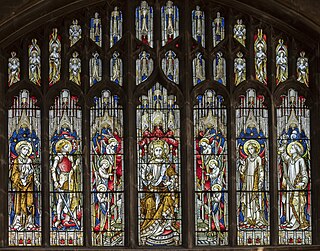
Hardman & Co., otherwise John Hardman Trading Co., Ltd., founded 1838, began manufacturing stained glass in 1844 and became one of the world's leading manufacturers of stained glass and ecclesiastical fittings. After the doors closed at Lightwoods Park Justin Hardman, a descendant of John Hardman kept the heart of the studio alive and with the help of chief designer, Artist Edgar JB Phillips they continue to design and manufacture exquisite traditional Hardman stained glass around the world.

Charles Eamer Kempe was a British Victorian era designer and manufacturer of stained glass. His studios produced over 4,000 windows and also designs for altars and altar frontals, furniture and furnishings, lychgates and memorials that helped to define a later nineteenth-century Anglican style. The list of English cathedrals containing examples of his work includes: Chester, Gloucester, Hereford, Lichfield, Wells, Winchester and York. Kempe's networks of patrons and influence stretched from the Royal Family and the Church of England hierarchy to the literary and artistic beau monde.

A revival of the art and craft of stained-glass window manufacture took place in early 19th-century Britain, beginning with an armorial window created by Thomas Willement in 1811–12. The revival led to stained-glass windows becoming such a common and popular form of coloured pictorial representation that many thousands of people, most of whom would never commission or purchase a painting, contributed to the commission and purchase of stained-glass windows for their parish church.
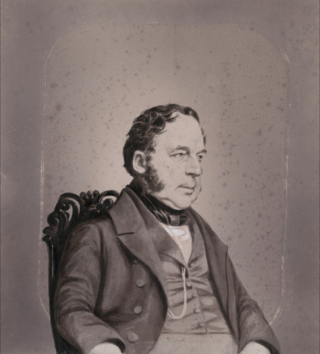
Thomas Willement was an English stained glass artist and writer, called "the father of Victorian stained glass", active from 1811 to 1865.

William Warrington, (1796–1869), was an English maker of stained glass windows. His firm, operating from 1832 to 1875, was one of the earliest of the English Medieval revival and served clients such as Norwich and Peterborough Cathedrals. Warrington was a historian of medieval glass and published an illustrated book The History of Stained Glass.
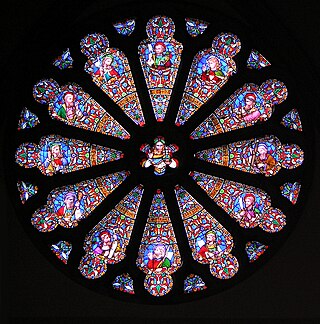
William Wailes (1808–1881) was the proprietor of one of England's largest and most prolific stained glass workshops.
The firm of James Powell and Sons, also known as Whitefriars Glass, were London-based English glassmakers, leadlighters and stained-glass window manufacturers. As Whitefriars Glass, the company existed from the 17th century, but became well known as a result of the 19th-century Gothic Revival and the demand for stained glass windows.

Clayton and Bell was one of the most prolific and proficient British workshops of stained-glass windows during the latter half of the 19th century and early 20th century. The partners were John Richard Clayton (1827–1913) and Alfred Bell (1832–1895). The company was founded in 1855 and continued until 1993. Their windows are found throughout the United Kingdom, in the United States, Canada, Australia and New Zealand.

Heaton, Butler and Bayne were a British firm who produced stained-glass windows from 1862 to 1953.

Burlison and Grylls is an English company who produced stained glass windows from 1868 onwards.

Shrigley and Hunt was an English firm which produced stained-glass windows and art tiles.

English Gothic is an architectural style that flourished from the late 12th until the mid-17th century. The style was most prominently used in the construction of cathedrals and churches. Gothic architecture's defining features are pointed arches, rib vaults, buttresses, and extensive use of stained glass. Combined, these features allowed the creation of buildings of unprecedented height and grandeur, filled with light from large stained glass windows. Important examples include Westminster Abbey, Canterbury Cathedral and Salisbury Cathedral. The Gothic style endured in England much longer than in Continental Europe.

Charles Clutterbuck (1806–1861) was an English stained glass artist of the early Victorian era, being a younger contemporary of Thomas Willement and William Warrington

Arthur Louis Moore was an English glass-maker who specialised in stained glass windows.
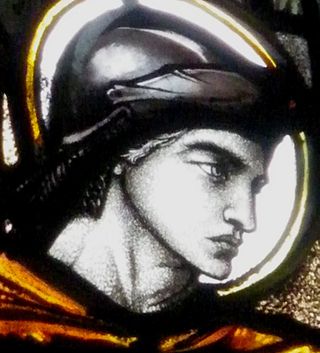
Rachel de Montmorency, née Rachel Marion Tancock, was an English painter and artist working in stained glass. She learned about stained glass when she worked for artist Christopher Whall in the 1910s and 1920s. During World War I she worked as a voluntary nurse.
John David Hayward (1929–2007) was a British stained glass artist who made nearly 200 windows in churches and cathedrals across Britain and abroad.
Rosalind Grimshaw BA FMGP was a stained glass artist who lived in Clifton, Bristol looking towards the Clifton Suspension Bridge. Grimshaw had Parkinson's disease from her early 30s.

St Mary's Church is a Roman Catholic Parish church in the Preston Village area of Brighton and Hove, East Sussex, England. It was built from 1910 to 1912 in the Arts and Crafts style of Gothic Revival architecture. It is situated on the Surrenden Road on the corner with Preston Drove opposite Preston Park. It was designed by Percy Aiden Lamb, a student of Edward Goldie, and is a Grade II listed building.
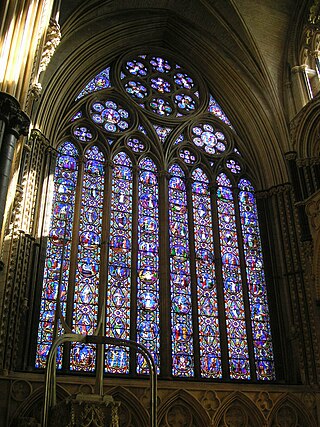
James Henry Nixon (1802–1857) was an illustrator and painter during the Victorian period, who worked in the firm Ward and Nixon painting stained glass windows. James Henry Nixon was a protégé of Charles Winston, who praised Nixon's work at Westminster Abbey and Church of Christ the King, Bloomsbury. The company Ward and Nixon was followed by Ward and Hughes.
{{cite book}}: CS1 maint: location missing publisher (link){{cite book}}: CS1 maint: others (link) ![]() Media related to Ward and Hughes at Wikimedia Commons
Media related to Ward and Hughes at Wikimedia Commons